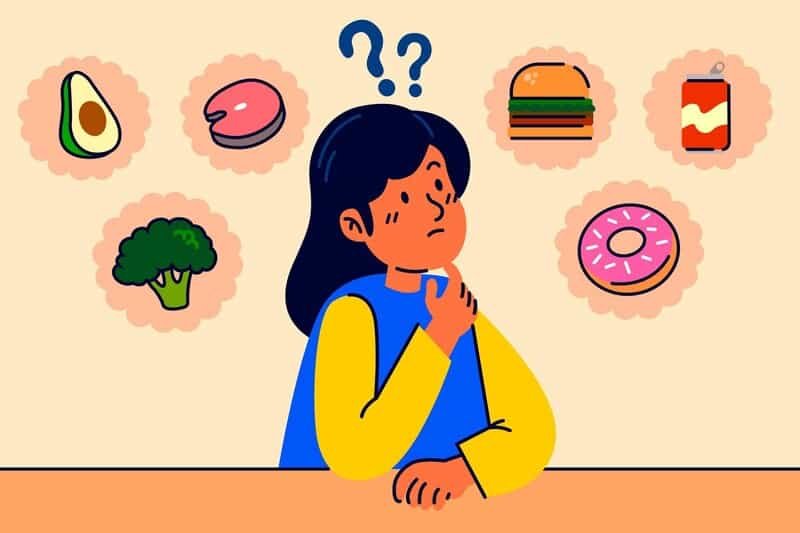Are you ready to dive into the world of keto but feeling a bit lost in the sea of information? You’re not alone! The ketogenic diet has taken the health and wellness community by storm, promising weight loss and increased energy. However, many newcomers make common missteps that can derail their progress faster than a carb-laden snack. In this blog post, we’ll uncover the 7 most frequent mistakes people make on the keto diet—and how to avoid them—so you can stay on track, maximize your results, and confidently embrace a healthier lifestyle. Let’s turn those rookie blunders into expert moves as we navigate this exciting journey together!
In This Article
- Introduction to the Keto Diet
- Explanation of the 7 Common Mistakes
- Mistake #1: Not Tracking Macros and Calories
- Mistake #2: Not Consuming Enough Fat
- Mistake #3: Not Eating Enough Vegetables
- Mistake #4: Relying on Processed
- Mistake #5: Not Staying Hydrated
- Mistake #6: Giving up too quickly
- Mistake #7: Ignoring electrolyte balance
- Conclusion
- Faqs
Introduction to the Keto Diet
The Keto diet has rapidly gained popularity in the health and wellness community. With promises of rapid weight loss, increased energy levels, and improved mental clarity, it’s no wonder many people are eager to jump on this low-carb bandwagon. However, as with any dietary change, some pitfalls can trip you up.
Whether you’re a seasoned Keto veteran or just starting your journey to ketosis, avoiding common mistakes is essential for achieving your goals. In this post, we’ll explore seven frequent missteps that could derail your progress and how you can steer clear of them. Let’s dive into these challenges so you can make the most out of your Keto experience!
Explanation of the 7 Common Mistakes
The Keto diet has gained popularity for its potential weight loss and health benefits. However, many newcomers stumble upon common pitfalls that can hinder their progress. Recognizing these mistakes is crucial for long-term success.
One significant error is the lack of tracking macronutrients. Staying from the intended carb limits is easy without monitoring your intake.
Another frequent misstep is insufficient healthy fats essential to this high-fat diet. Many overlook the importance of incorporating ample fat sources into their meals.
Additionally, neglecting vegetables can lead to nutritional deficiencies over time. Low-carb veggies play a vital role in providing nutrients and fiber.
Processed “Keto” products often contain hidden ingredients that may derail your efforts. Emphasizing whole foods instead can offer more clarity on what you’re consuming.
Hydration also deserves attention; failing to drink enough water can impact the overall well-being of this specialized eating plan.
Mistake #1: Not Tracking Macros and Calories
Tracking macros and calories is crucial for anyone on the keto diet. Many people underestimate its importance. Without this vital information, you will stray from your goals.
When you don’t, you might consume more carbs than intended. This can kick you out of ketosis, undermining all your hard work. Keeping an eye on both macronutrients and total calorie intake ensures you’re you’re your dietary needs.
Using apps like MyFitnessPal or Cronometer can simplify tracking. These tools allow you to log meals quickly and provide insights into the nutrient composition.
Developing a habit of recording what you eat makes it easier to spot trends over time. Which foods keep you in ketosis, and which may hinder progress? By taking control of your food choices, you’ll be better equipped for success on the keto journey.
- Importance of tracking
Tracking your macros and calories is crucial on the keto diet. It provides clarity about what you’re consuming daily. This awareness helps ensure you stay within your carb limits while hitting fat and protein targets.
Many people underestimate how easily carbs can sneak into their meals. By tracking, you better understand portion sizes and the nutritional value of foods.
Using apps or simple food diaries can enhance accountability. When you log every meal, it becomes easier to spot patterns in your eating habits.
Additionally, tracking allows for flexibility in planning meals that align with your goals without falling off track. You’ll also be empowered to make informed decisions when dining out or trying new recipes.
Ultimately, keeping a close eye on what goes into your body supports long-term success on the keto journey.
- How to track effectively
Tracking your macros doesn’t have to be overwhelming. Start by selecting a reliable app that suits your style. Popular options include MyFitnessPal and Cronometer, which make logging food simple.
When you log each meal, weigh ingredients for accuracy. Using a kitchen scale can help prevent underestimating portion sizes.
Consider setting reminders on your phone to encourage consistent tracking throughout the day. This slight nudge can keep you accountable and ensure nothing slips through the cracks.
Also, take note of how certain foods affect your body. Document any changes in energy levels or cravings after eating specific meals; this will guide future choices.
Finally, don’t forget to review weekly progress reports from your app. These insights will allow you to adjust your plan as needed while keeping things fresh and exciting in the kitchen!
Mistake #2: Not Consuming Enough Fat
A common pitfall on the keto journey is skimping on fat. This might seem counterintuitive since the diet emphasizes high-fat intake, but many people hesitate to embrace it fully.
Fat serves as your primary energy source in a ketogenic lifestyle. When you cut back, you risk depriving your body of essential fuel and nutrients. This can lead to fatigue and cravings for carbohydrates.
Incorporating healthy fats into your meals is crucial. Think avocados, olive oil, nuts, and seeds. These not only enhance flavor but also keep you feeling satisfied longer.
Experiment with different cooking methods to enjoy fatty foods in new ways. Roasting vegetables in olive oil or adding coconut milk to smoothies are simple yet effective strategies.
Remember, embracing fat isn’t just about weight loss; it’s vital for overall health while following this unique dietary path.
- Importance of fat in a Keto diet
Fat is the cornerstone of the ketogenic diet. It fuels your body and keeps you feeling satiated throughout the day. Unlike other diets that may push for low-fat options, keto thrives on healthy fats.
When your body enters ketosis, it shifts from burning carbohydrates to burning fat for energy. This metabolic state can help improve mental clarity and boost physical performance.
Not all fats are equal, though. Incorporating various sources—like avocados, olive oil, nuts, and fatty fish—is crucial for optimal health benefits. These foods provide essential nutrients while keeping your meals delicious.
By prioritizing fat intake, you’re not just following a trend; you’re giving your body what it needs to thrive in a lower-carb environment. Embrace this shift to enjoy sustained energy levels and better overall well-being as you navigate your keto journey.
- High-fat foods to add to your meals
Incorporating high-fat foods into your meals is essential for a successful Keto diet. These fats not only provide energy but also keep you feeling satiated longer.
Avocados are a fantastic choice. They’re packed with healthy monounsaturated fats and nutrients. Add slices to salads or blend them into smoothies for a creamy texture.
Coconut oil is another excellent option. It’s versatile and can be used in cooking or baking, giving dishes a subtle flavor while boosting fat content.
Don’t overlook nuts and seeds, like almonds, walnuts, and chia seeds. They make perfect snacks or toppings for yogurt and salads.
Lastly, consider fatty cuts of meat such as ribeye steak or chicken thighs with skin on. They’re deliciously rich in flavor while keeping your macros on track.
Experimenting with these options will enhance your meal variety while staying true to the principles of the Keto lifestyle.
Mistake #3: Not Eating Enough Vegetables
Many people think of the keto diet as just meat and cheese. However, vegetables are crucial in maintaining balance while on this low-carb journey.
Low-carb veggies are packed with essential vitamins and minerals. They provide fibre, which helps with digestion—a vital aspect when transitioning to ketosis. Ignoring these green gems may be missing critical nutrients supporting overall health.
Add options like spinach, zucchini, broccoli, and cauliflower to your meals. These choices keep your carb count in check and add variety to your plate.
Don’t hesitate to try out various cooking techniques! Roasting or sautéing can enhance flavors and make veggies more appealing. Embracing a colorful array of low-carb vegetables will help sustain energy levels while keeping cravings at bay.
- Role of vegetables in a Keto diet
Vegetables play a crucial role in a successful Keto diet despite the misconception that they should be avoided. They provide essential vitamins, minerals, and fiber that support overall health.
Incorporating low-carb vegetables can help maintain nutrition while keeping carbohydrate intake in check. Options like spinach, kale, zucchini, and cauliflower are excellent choices that add flavor without derailing your progress.
These veggies also aid digestion and promote satiety. Their high water content helps keep you hydrated, too.
Furthermore, colorful vegetables introduce antioxidants to your meals. This protects against inflammation often associated with dietary changes.
Finding creative ways to include these greens can elevate your dishes. Whether it’s sautéing them as side dishes or blending them into smoothies, variety keeps the diet enjoyable and sustainable!
- Low-carb vegetable options
When following a Keto diet, incorporating low-carb vegetables is essential. These veggies provide vital nutrients without spiking your carb intake.
Leafy greens are always a great choice. Spinach, kale, and arugula can be easily added to salads or smoothies for an extra nutrient boost.
Cruciferous vegetables like broccoli and cauliflower are also fantastic options. They’re versatile and can be roasted, steamed, or even turned into rice alternatives.
Don’t overlook zucchini! This squash is perfect for making noodles or adding to stir-fries.
Other options include bell peppers, asparagus, and mushrooms. Each brings unique flavors while keeping carbs in check.
Experimenting with different combinations enhances meals and helps maintain variety on your plate.
Mistake #4: Relying on Processed
Many mistakenly assume that all processed “Keto” products are safe and healthy. However, this can lead to hidden pitfalls in your diet.
These products often contain artificial sweeteners, preservatives, and unhealthy fats that sabotage your progress. Reading labels is crucial; what appears keto-friendly might not be as wholesome as it seems.
Instead of reaching for pre-packaged items, focus on whole foods whenever possible. Fresh meats, eggs, avocados, nuts, and leafy greens should form the foundation of your meals.
Not only will they provide essential nutrients, but they’ll also keep you feeling full longer. Embracing a variety of natural ingredients helps maintain balance while keeping cravings at bay.
- Hidden ingredients in processed products
When you reach for processed “keto” products, it’s easy to assume they fit perfectly into your diet. However, many are laden with hidden ingredients that can sabotage your efforts.
Sugar alcohols and artificial sweeteners often appear in these snacks. While they may seem low-carb, they can impact blood sugar levels and cause digestive issues for some individuals.
Preservatives and fillers are also common culprits. These additives add unwanted calories and can disrupt gut health over time.
Reading labels is essential. Ingredients like maltodextrin or cornstarch might be lurking where you least expect them.
Opting for whole foods ensures you’re nourishing your body without the mystery of unpronounceable substances. Fresh vegetables, quality meats, and healthy fats should always be the priority on a keto journey—keeping it simple means keeping it practical, too!
- Whole food alternatives
When navigating the keto diet, it’s essential to steer clear of overly processed “keto” products. Many of these items are marketed as health foods but can contain hidden sugars and unhealthy fats.
Instead, focus on whole food alternatives that provide natural nutrients without unnecessary additives. Fresh avocados, for example, are a fantastic source of healthy fats and fiber. They can enhance salads or be blended into creamy smoothies.
Nuts and seeds also play a crucial role in your meal prep. Almonds, walnuts, and chia seeds offer protein while keeping carb counts low.
Don’t overlook leafy greens like spinach or kale; they’re packed with vitamins and minerals that support overall health while fitting perfectly into your macros.
Lastly, embrace high-quality meats and seafood as staples in your diet. Grass-fed beef or wild-caught salmon delivers essential fats and contributes to daily satiety.
Mistake #5: Not Staying Hydrated
Staying hydrated is often overlooked, yet it’s crucial for anyone on the Keto diet. When your body enters ketosis, it excrete more water and electrolytes. This increased fluid loss means you need to drink more water than usual.
Adequate hydration helps maintain energy levels and supports overall bodily functions. If you ignore this aspect of your health, you may experience fatigue or headaches—symptoms commonly mistaken for “keto flu.”
Try to drink at least 8 to 10 glasses of water daily. You can also supplement with electrolyte-rich drinks low in carbs to help replenish lost minerals.
Keeping an eye on hydration will support weight loss efforts and enhance mental clarity. Don’t let dehydration derail your keto journey; prioritize drinking enough fluids!
Mistake #6: Giving up too quickly
The keto diet is notorious for its strict rules and regulations, making it a challenging lifestyle change for many people. As a result, one of the most common mistakes people make on this diet is giving up too quickly. It’s understandable to feel discouraged when you don’t see immediate results or have difficulty sticking to the low-carb, high-fat eating plan. However, throwing in the towel too soon can prevent you from experiencing the numerous benefits of the keto diet.
One of the main reasons why people give up on the keto diet prematurely is because they are not seeing significant weight loss right away. While some individuals experience rapid weight loss in the first few weeks of starting this diet, others may take longer to see results. The body needs time to adjust to burning fat instead of carbs for energy, which can take several weeks or even months for some individuals. Therefore, it’s crucial to be patient and stick with it before deciding that the keto diet isn’t working for you.
Mistake #7: Ignoring electrolyte balance
The keto diet has gained popularity recently for its potential weight loss and health benefits. However, like any diet, it is essential to be aware of possible pitfalls and mistakes that can hinder your progress. One common mistake that many people make on the keto diet is ignoring their electrolyte balance.
Electrolytes are minerals in our body that have an electric charge, such as sodium, potassium, magnesium, and calcium. They are crucial in regulating various bodily functions, including nerve and muscle function, hydration levels, and maintaining proper pH balance. When following a strict low-carb or ketogenic diet, our bodies go through significant changes as we transition from using glucose as our primary fuel source to ketones. These changes can disrupt our electrolyte levels and lead to unpleasant symptoms.
One of the most common side effects of electrolyte imbalance on the keto diet is the “keto flu.” This includes symptoms such as fatigue, headaches, muscle cramps, dizziness, brain fog, and constipation. These symptoms can be attributed to a lack of essential electrolytes.
Cutting out carbohydrates means cutting out many foods that are high in electrolytes. Foods such as fruits, starchy vegetables like potatoes or corn, and grains are all sources of electrolytes. Drastically reducing or eliminating these foods from your diet on a ketogenic plan without replacing them with other sources of electrolytes can lead to deficiencies.
Another factor contributing to imbalanced electrolyte levels is increased fluid intake due to increased thirst on the keto diet. As carbohydrates hold onto water in our bodies (which is why we experience rapid weight loss when we first start), when we cut them out drastically on the keto diet, we also lose this retained water, leading us to dehydration if we are not careful about replenishing fluids.
To avoid these issues while following a low-carb or keto lifestyle, it’s vital to pay attention to your daily intake of electrolytes. Some ways to ensure you get enough electrolytes include consuming foods high in these minerals, such as leafy greens, nuts and seeds, avocados, and bone broth. You can also incorporate electrolyte supplements such as magnesium citrate or potassium chloride into your daily routine. Moreover, staying hydrated is crucial, so you should consume plenty of water during the day.
Electrolyte balance is crucial to maintaining overall health while following a ketogenic diet. Neglecting this can lead to unwanted symptoms and hinder your progress towards achieving your goals. By being mindful of your intake of electrolytes and incorporating them into your diet through food sources or supplements, you can avoid the keto flu and maintain proper bodily functions on your low-carb journey.
Conclusion
The ketogenic diet has become increasingly popular for its numerous health benefits, but as with any lifestyle change, there are common mistakes that people make. By avoiding these seven mistakes and adequately implementing the keto diet, you can see positive results in your weight loss journey and overall well-being. Speak with a healthcare provider before beginning any new diet or exercise program. With dedication and knowledge, you can successfully navigate the ketogenic lifestyle and reap its many rewards. Stay focused, stay motivated, and enjoy the journey towards a healthier you!
Faqs
As with any diet, the keto diet comes with its own set of questions and concerns. In this section, we will address some of the most frequently asked questions about the keto diet to help clear any confusion and ensure that you are on the right track toward achieving your health and weight loss goals.
Q: What’s the time frame for entering ketosis?
A: The time it takes for your body to enter into a state of ketosis can vary from person to person. It typically takes 2-4 days for your body to deplete its glycogen stores and produce ketones, but it may take longer for some individuals.
Q: What are some signs that I am in ketosis?
A: Some common signs that you have entered into a state of ketosis include increased energy levels, decreased appetite, bad breath (also known as “keto breath”), and weight loss. You can also use urine strips or blood tests to measure the levels of ketones in your body.
Q: Is it permissible to consume alcohol while following the keto diet?
A: While certain types of alcohol, like beer and sugary cocktails, should be avoided due to their high carbohydrate content, there are still options for those who enjoy an occasional drink. Dry wines, spirits like vodka or whiskey, and sugar-free mixers can be consumed in moderation while following a keto diet.
Q: Will I experience the “keto flu”?
A: Some people may experience flu-like symptoms such as headaches, fatigue, and nausea during the first few days or weeks of starting a keto diet. This is commonly referred to as the “keto flu” and is caused by your body adjusting to using fat as its primary fuel source instead of carbohydrates. These symptoms typically fade away within one to two weeks.
Q: Is it necessary to track calories while following a keto diet?
A: While calorie counting is not necessary on the keto diet, it is essential to keep track of your macronutrient intake (fat, protein, and carbohydrates) to ensure that you are in a state of ketosis. Eating too many calories, even from healthy fats, can hinder weight loss on the keto diet.
Q: Is the keto diet safe for everyone?
A: The keto diet is generally considered safe for most individuals. However, those with certain medical conditions, such as diabetes or kidney disease, should consult their doctor before starting the diet. Pregnant and breastfeeding women should also avoid the keto diet due to its restrictive nature.







